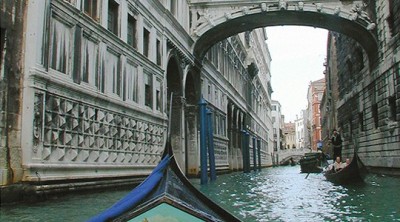
The novelist, biographer, and cultural historian Peter Ackroyd is one of the most eclectic and prolific living authors. His many works embrace an extraordinary range of topics, and this new documentary (originally broadcast on Great Britain's Channel Four) tackles the enormous subject of Venice's influence on Western culture and society. Adapted from his own book, Venice Pure City (not yet published here in the US), Venice Revealed is a four-part documentary series that engrossingly examines the cultural history of the city from a perspective that winningly combines objective research with subjective interpretation and analysis. Ackroyd has a novelist's sensibility, and here it affords great insight rooted in curiosity and keen observation.
Marked by lovely photography, music, and an attention to the finer details of Venice's public places, Venice Revealed is divided into four thematically-organized episodes. Each explores one of Venice's cultural products, but Ackroyd's perspective is cross-disciplinary, with a view to the interplay of the one with the other three. He is not interested in compartmentalizing architects, painters, composers, and dramatists; he maintains a focus on how the creations of these figures have changed over time and affected the city and the world's perception of it. It's an invigorating approach that examines the impact of creative work in terms of its influence and continued importance.
Episode One - The City as Architecture: Part of Ackroyd's abiding interest in Venice stems from the fact that the city didn't grow from agrarian or commercial origins. It was planned as a city from its earliest beginnings. The buildings of Venice have foundations that rest on a submerged petrified forest - it really is, in a way, a floating city, built upon a large body of water. Its buildings comprise an irregular mixture of styles - from the earliest Byzantine and the high Gothic to the neo-classicism of the Renaissance, Venice's architecture is a hodgepodge of styles from many different eras. Some buildings have Byzantine origins, with Gothic ornamentation, and even later Renaissance additions. Ackroyd surveys the city's architectural history with the help of Venetian scholars.
Episode Two - The City as Art: Ackroyd looks at Venice through the eyes of its great home-grown painters, particularly Tintoretto and Canaletto. These artists were devoted to the city, representing it directly in ambitious cityscapes that established patterns of color that are now recognized as "Venetian," and indirectly in sacred works that used the city's layout and cultural hierarchy as templates for their design. Bellini, Tiepolo, and Bassano were also Venetians - some of these painters never left the city. Their work is of, by, and for Venice.
Episode Three - The City as Music: Venice was a great producer of music, particularly in the Renaissance and Classical periods. Monteverdi and Wagner lived out their last days in the city. Its most important native composer was Antonio Vivaldi, and Ackroyd explores his life and work through the lens of recent research conducted by Vivaldi biographer Micky White. She has uncovered information about an all-female musical ensemble that existed in Vivaldi's era, which has recently been reconstituted with the help of an Oxford choral scholar. In this way, the episode effectively uses Vivaldi's own music to bridge his time to our own.
Episode Four - The City as Theatre: In the most vague and loosely-constructed episode in the series, Ackroyd takes on the term "theater" in all its implications: not only is dramatic and operatic performance surveyed, but so is the concept of the entire city serving as a gigantic piece of living theater. Buildings are examined as contrived slabs of fakery; paintings are assessed as silent, theatrical "performance" pieces; and public events such as Carnival - and even executions - are considered for their dramatic, performative aspects. Throughout its history, Ackroyd suggests, Venice has not so much been revealed as concealed - by layer upon layer of artifice and contrivance.

No comments:
Post a Comment